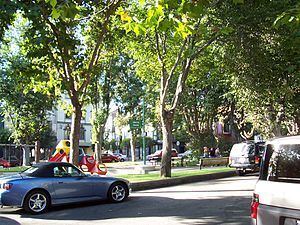Open All year | Created 1852 Area 3,440 m² | |
 | ||
Status Closed, under renovation | ||
South Park is a small urban park and eponymous neighborhood in the larger South of Market neighborhood of San Francisco, California, consisting of 0.85 acres (0.34 ha) of public ground. The neighborhood centers on the small, oval-shaped park and South Park Street, which encircles the park. South Park is bounded by Second, Third, Bryant, and Brannan streets.
Contents
- History
- Current
- Architecture Engineering Design
- Arts Culture
- Food Beverage
- Media Web
- Technology
- Venture Capital
- Former
- Neighbors
- References
The two halves of the South Park Street re-join at both ends of the park and continue for short, straight stretches before terminating at Second Street on one end and Third Street on the other. This creates a curved line of buildings, which gives the street and park an unusual enclosed, urban character. Local businesses and restaurants dot the street, as well as a large number of apartment buildings.
In January 2016, the park was closed temporarily in order to undergo a $2.8 million renovation, which will include comprehensive infrastructural and cosmetic upgrades.
History
The South Park block was assembled in 1852 by English entrepreneur George Gordon.
The park was originally constructed in 1855 as the center of an exclusive residential community. It was modeled after a square in London, England, as a housing development of seventeen mansions plus townhouses (a total of 58 residences) on a 550-foot oval around a private grassy park. It featured the first paved streets and sidewalks in San Francisco. A windmill in the center of the park pumped water for the houses.
From the late 19th to the early 20th century, South Park was also the center of one of San Francisco's largest Japanese American communities. Sandwiched between the waterfront and the South Pacific Railroad terminus, the area featured Japanese owned and operated hostels, hotels, baths, and shops. Many of the structures remain: the Madrid Hotel occupies what once was the Eimoto Hotel at 22 South Park.
The neighborhood began to lose exclusivity after the construction of Second Street, which made the area accessible to less affluent residents. Rich residents moved to the newer Nob Hill neighborhood in the late 19th century, and the city took over the park in 1897. It suffered further decline after the San Francisco earthquake of 1906, when most of the homes around the Rincon Hill neighborhood were destroyed. The oval park, however, has remained unchanged and is still a central meeting place in the neighborhood. After the quake, the neighborhood was rebuilt as warehouses, light manufacturing, nightclubs, and hotels. Immigrants from various countries came to the neighborhood, as well as longshoremen, drug addicts, and vagrants. The neighborhood began to attract artists and young professionals beginning in the 1970s.
The area flourished during the dot-com boom of the late 1990s, due to flexible office space at initially low rent. It was sometimes described as "ground zero" of the dot com revolution, with many start-up Internet companies based in the area. By late 2001, however, many of these companies had closed their doors. Yet, as of 2006, in an era for the Internet that some have dubbed Web 2.0, South Park has once again become home to many small Web-related companies.
Recently, some neighbors in South Park have expressed opposition to a proposal to put an above-ground stop on the Central Subway at the southwestern end of South Park Street, on Third Street. Finally the routing of the line has been decided by the Municipal Transportation Agency, and will be along Fourth Street, one block farther west.
Current
(as of January 2016)
Architecture, Engineering, & Design
Arts & Culture
Food & Beverage
Media & Web
Technology
Venture Capital
Former
Neighbors
South Park is located between the San Francisco–Oakland Bay Bridge (Interstate 80) and AT&T Park, the city's baseball stadium. Many of the nearby streets are one-way, and many carry traffic to and from the bridge, the stadium, and Interstate 280, which terminates slightly to the south of the neighborhood.
AT&T Park (formerly Pacific Bell Park, then SBC Park), where the San Francisco Giants major league baseball team plays, is two blocks south and east of South Park.
Moscone Center, San Francisco's main convention facility, is four blocks north and west of South Park.
